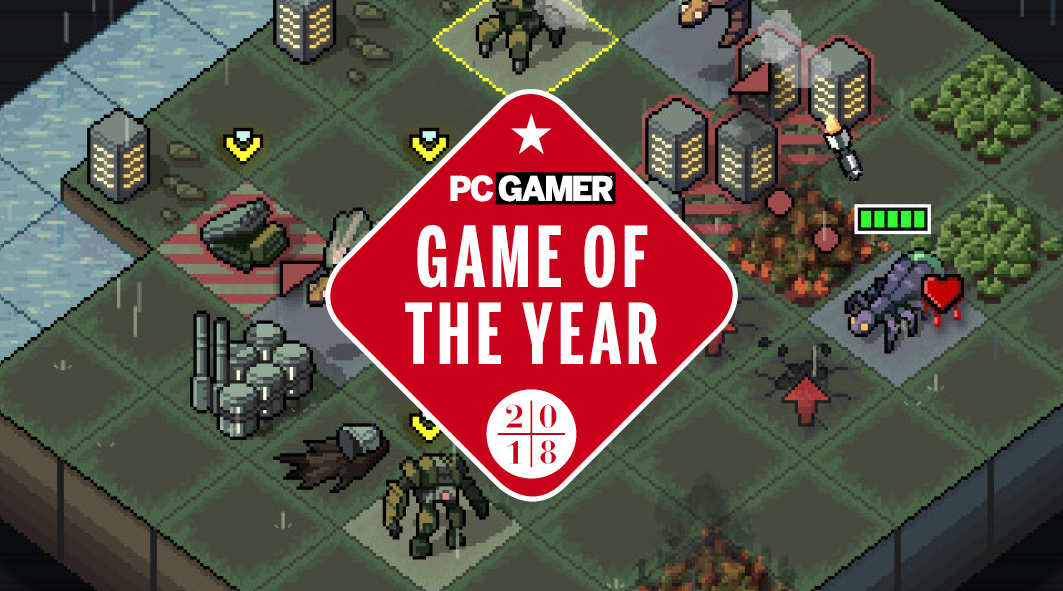Ultimate Game of the Year 2018: Into the Breach
The creators of FTL brought us a tactical roguelike masterpiece.

Having already reached number four in our Top 100 list earlier this year, we're delighted to name Subset Games' Into The Breach our Ultimate Game of the Year for 2018, joining past winners like Divinity: Original Sin 2, Dishonored 2, Metal Gear Solid 5: The Phantom Pain, and Alien: Isolation. Check out the now-completed list of GOTY awards and personal picks.
Tom: Into The Breach shows that you can create tactical intrigue without force-feeding the player a 100-page manual. This game gives you an eight-by-eight grid, a few enemy types, and squads of cool mechs with different attacks and… that’s it. It even tells you exactly what’s going to happen next turn, and it’s still a fascinating tactics game that you can enjoy in snackable short sessions. It’s elegantly designed and accessible enough to appeal to people that might not think of themselves as strategy gamers. Battles feel like emergent puzzles rather than serious tests of martial skill, but it’s still quite hard, particularly when parts of the arena start flooding, or collapsing away completely.
Evan: When you unlock a new set of mechs it feels like ripping open a new set of Pacific Rim action figures, a trio of robots that form a unique fighting style. The Flame Behemoths torch everything. The Rusting Hulks use smoke to disable enemies. The Steel Judoka are all about setting up sweet suplex combos. And upgrading these bots almost always feels like a tough choice between survivability or movement, between attack power and utility. Into the Breach's dedication to less-is-more design makes this possible.
Samuel: Like FTL, it's a perfect modern form of strategy game that's engaging and easy to pick up without being too complicated. Plus you can play it in tiny chunks. One of Into The Breach's strengths over FTL is how difficulty scales: easy is a steady way to enjoy the game and get used to its systems, while normal is tough moment-to-moment but well-balanced. Each set of mechs is like playing an entirely different game—and the sense of discovery that comes with working out how their various abilities fit together to dismantle a Vek assault in a single turn feels like magic. The path to unlocking them all gives players a generous amount of game to dig into.
Then there's the touch of letting you abandon a timeline in the event that the Vek wins—which will happen a lot. Not only does it give you a sense of continuity between playthroughs, letting you keep some form of progress, it also underlines what a hopeless, unending battle it is that your little mech dudes face. The little bits of narrative here or there do enough to bring the world to life without ever wasting a second of your time.
Then there's the variety provided by the game's different islands: airstrikes, trains you have to defend, evil AI battlebots, temporary allied units, being able to dump acid on enemies, blowing up mountains to stop the Vek reproducing. There's so much here to keep things surprising.
Wes: One of Into the Breach's small, brilliant decisions was putting the focus of each mission on saving civilians, rather than your own mechs. It has me doing scary math every turn: should I put one of my units in the line of fire to take a hit? If they die, losing some of the special abilities they've accrued by leveling up, is that worth the trade-off of protecting the precious energy meter? A single civilian loss can feel devastating, but this framing sets the tone for the whole game. It's about surviving, not killing 'em all, and lasting long enough for the Vek to retreat had me pumping my fists like it was a massive victory.
The biggest gaming news, reviews and hardware deals
Keep up to date with the most important stories and the best deals, as picked by the PC Gamer team.
I also appreciate that almost everything in Into the Breach feels finely calculated and deliberately un-random, except for the grid defense stat. In most runs that number's going to stay low, maybe 20 percent, meaning you have just a one in five chance of a building deflecting damage that should've destroyed it. But when that happens—when the clouds part and the god of RNG bathes you in a pure, protective light—euphoria.
When it happens twice in a row when you're facing certain ruin? Post-euphoria. Is that a thing? Whatever's better than euphoria. Game of the year.
Phil: That you can see exactly what your enemy is going to do before they take their turn is everything. There are no surprises, just precise, accurate information detailing exactly how screwed you currently are. It's great if you can finish a turn without any buildings being destroyed, but it's rarely enough. You also have to avoid taking too much damage yourself and, if you ever want to upgrade your squad, complete a bonus objective too. But, because you know how and where your enemy is going to attack, you have a chance to turn things to your advantage. To push a bug here into the path of another enemy's attack. To deliberately take damage in order to save a valuable building. To not kill an enemy, but instead move them in such a way that they'll block reinforcements on the next turn. Into the Breach is constantly putting you in impossible seeming situations, but also gives you the time, information and tools to think your way back out.
Check out Alex Wiltshire's original 93%-scored review.


